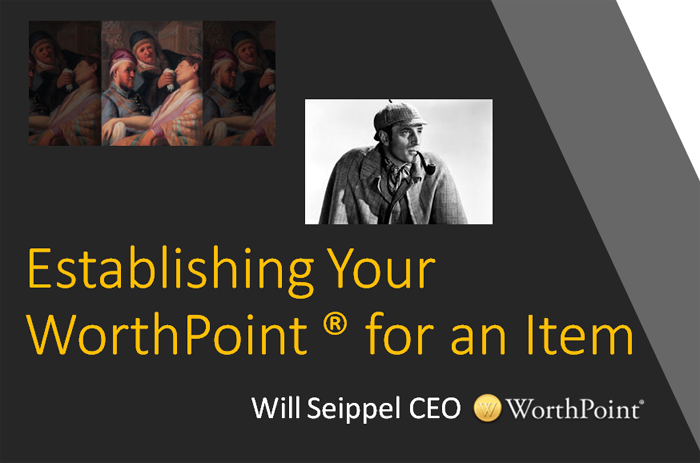
Will Seippel: This is a presentation that I gave at our last treasure hunt down in Fort Lauderdale trying to show some of the different sides of WorthPoint and some of the things that we’ve done over the years.
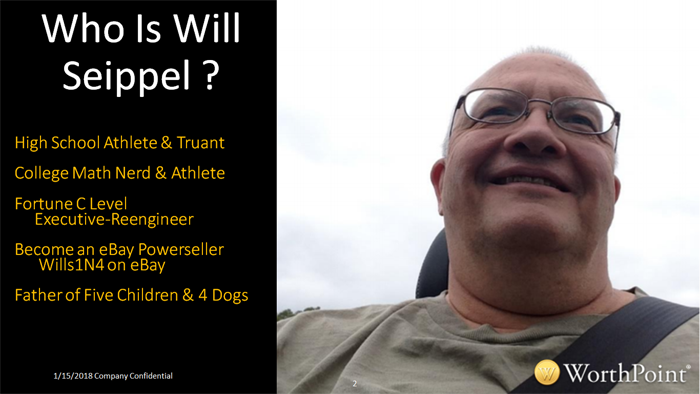
A little bit about who I am. A lot of people don’t know that I started life as an athlete. I was going to go and play sports. I was a true truant. I didn’t show up a whole lot for school, but I did show up for sports. I got hit by a drunk driver in my senior year, so I ended up having to change my focus in life and start going to school.
I actually became a math nerd and was able to play some less violent sports than football and wrestling in college. Most of the people at WorthPoint, Danna is going to laugh when I say we’re nerds. We have a very high math and computer science background. I think that’s one of the things that makes WorthPoint really different, besides understanding the world of antiques.
I went out in the fortune world and was a C level executive at many very large companies that are household names. Decided at 50 I was going to quit all that, and I became an eBay seller. Really took the background I had from growing up in rural northwest Virginia and buying and selling a lot of Civil War relics that we would find in the ground and learning about history and turning it into a career later and become a power seller on eBay.
My eBay handle is Wills1N4. I think I have somewhere around 16,000 feedback on eBay, and I’ve sold about a million dollars on eBay over the years. It’s not the only place I sell, but it’s the primary place I sell. I don’t sell anywhere else online.
I am the father of five great kids, and I have four dogs. One of them is coming in the mail in another week. That’s exciting!
WorthPoint and who we are

WorthPoint was created out of need. When I started selling on eBay about 10 or 15 years ago, I promise everybody I did not drop out of the womb and know everything about everything about antiques, and I still don’t know everything about antiques. I still make mistakes occasionally and invite people to help me edit my eBay listings, because I sell about anything. WorthPoint, I needed a better place to do research for what I was selling on eBay. I think research is critical to us getting our listings right and, for a lot of reasons, getting more money.
When I started to do my research, occasionally I’d get a reminder from eBay that something wasn’t listed correctly. Civil War buttons is a tough one. It would take so long to go out on Google, which I think was a better tool than it is today, and try to find what I need out on the internet browsers. It was like, why can’t somebody save all this stuff in one place and create databases for us to do our research on? That was really the beginning of WorthPoint.
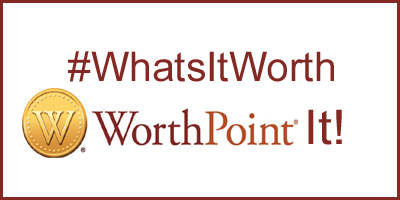
Now we have over a billion item images on WorthPoint, and over half a billion items, auction records. WorthPoint gets better every day with the great people that we have here. I was showing Danna today that it’s shocking to believe that WorthPoint is in the top 1,000 US trafficking websites. If you look at Quantcast, we’re actually 803 today. A lot of people use it, and it’s a trusted destination. We partner to auction houses around the world, especially eBay, who’s committed to making research in the market more transparent. eBay has a lot of the data here on WorthPoint. You can actually in some cases go back and find things that sold 15 years ago on eBay.
We have over 13,000 paid members today, and we’re quickly becoming, and it’s a trademark that we’ve registered, we’re becoming the internet of stuff. Eventually you’ll be able to track who owned things before on WorthPoint and find out their history that way. That’s something we’re actively working on, and some auction houses have talked to us about, to cut down on fraud.
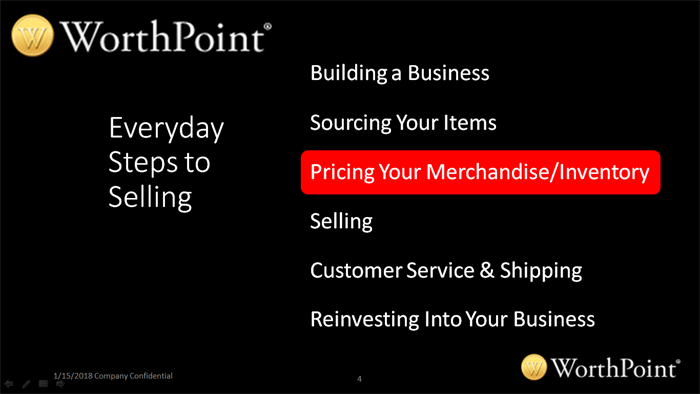
There’s a lot of things to do as a seller in everyday steps. I go around the country doing a lot of presentations on how to become a more effective seller. Again, last year I sold part-time, because I don’t do this full-time. I run WorthPoint full-time. I sold about $150,000-$200,000 part-time.
Everyday steps to selling.
There’s a lot to know, and while you can do it casually, people need to understand that this is a job like any other job. It involves work, which is a four letter word. For me, it’s fun, and a lot of fun, because I really like doing the work that I do as a seller.
There’s different facets to this, and we’re only going to go into pricing your merchandise today. I look at building a business, sourcing your items. Sourcing I thought would be the hardest part, but I don’t think it is. Pricing your merchandise, selling, customer service, and reinvesting in your business. These are all steps that we need to take as sellers. I get a lot of questions about sourcing.
Where do I find things? I have to laugh. I got a text message this morning for the fourth time asking me to come to somebody’s house on Friday, and for the fourth time I told them we’re in Memphis doing a treasure hunt. If you can join us in Memphis, we’re going to have a lot of fun. We’re even going to go down to the Grand Ole Opry coming up this weekend. Pricing your merchandise, to me, is critical to getting this whole equation right. There’s really not a science to it. It involves a lot of intuition, and WorthPoint is certainly a good starting point.
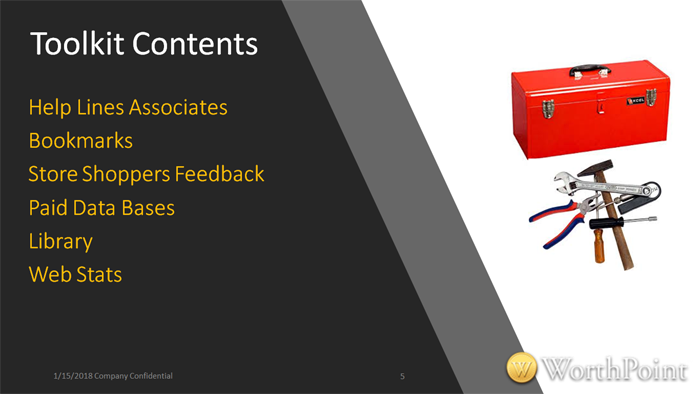
I think that we, as sellers, have to have a toolkit.
You look at a carpenter, and you don’t come to somebody’s house to do work without a toolkit. If you do, you certainly won’t get very far. A seller needs to have a toolkit on how to do pricing. Some of these things are free. Some of them you build up relationships in your business, and some of them are certainly a learning process. You’re not always going to make money on everything, because it is a learning process.
The first one I think is the most important, help lines to associates. There’s people that I have on my call list that I don’t call too often, so I don’t wear out my welcome, but I’ll call them and try to get help on identifying and pricing something.
There’s a piece I was talking to Danna about a little bit that I’m pretty excited about that we came by over the weekend, which is a sketch done in 1962 by Alan Shepard, the astronaut, on designing the orbit capsules and looking ahead and predicting in 1969 that man was going to be on the moon. This was back, he was predicting this in 1962 and doing the drawings. I have a help line, an auction associate, on how do I price that. It was found in a scrapbook, and he signed them. These are things I don’t know.
Danna was with me at Scott’s Flea Market, and we found a really nice Japanese print. I also don’t read Japanese, so my help line was my daughter, who does read Japanese, and getting her to read it. The help lines are really critical for people that know a lot more about you in a domain or subject, and who you can pick and call. Now you can send pictures and just get help right there. I won’t use the words my daughter used to help me understand who the Japanese print-maker was, but it was a good printmaker, and it was pretty fun.

The next thing to do that I use a lot, while WorthPoint is my primary place for shopping or getting price data on the web, I do use other sites, and I bookmark them on my computer, so I can find them real often. There are sites. One that quickly comes to my mind is when you’re looking at pocket watches, the watches are generally serial numbers that were done in order, and you can tell by what year and a lot about the watch by the number. I’ll go to different websites that have the pocket watch serial numbers in them and get a lot of information right off those websites. It’s really good information.
I also get information on my listings from different people. I learned something last night that I didn’t know about a ship’s telegraph, which is the speed control that the operator uses, about a World War II ship’s telegraph. I invite my people that come to my store to give me feedback about my listings. Do I have it all right? That’s really important. Sometimes they can help me increase the value, and sometimes it’s bad news, and I missed something and the value comes down. Recently I even got fooled by a Coca-Cola tray with Johnny Weissmuller.
Paid databases such as WorthPoint, I can’t stress enough that I think we’re the best value in the industry. For $19.95 a month, or $200 a year, you get access to our price database. We have some other databases that sell quite well. One is called MAPS, that has marks, autographs, patterns, and symbols. WorthPoint, by far, is the best price database out there. You can compare to anyone you want, and it’s by far the best value for the money. We also have a library, but I know a lot of dealers that build their own libraries at home with books. We have over 1,000 titles online in our library that you can rent by the year. It has good browsing tools.

I think all these things are just real important. eBay has, in their seller hub, great web stat services that come along with different levels of membership. I’m an anchor store on eBay, so I know I have all that. I don’t know if everybody does. Again, that’s another good piece of my toolkit, to look at how much traffic I’m getting on an item and what my web stats are in regards to it.
I think these are just really important things that we have to start making up how do we make our mind about how we want to price things. What tools you need really depends on the width of your focus. I know there’s people that deal in pocket watches that are never going to need any other databases, because I guess they know everything they can know about pocket watches. It’s great if your niche is that narrow. I think it’s hard to be that narrow and always be a successful seller. Danna and I were joking about we sell anything. If it’s legal, and I can make money on it, I’ll sell it. I’ve sold everything from parts to paintings. If you go to my website, you’ll see that there’s quite a bit on there in my eBay store, from $5 to $20,000. ( Wills1N4 )
Another thing is how much do you value your time? I can’t stress this enough. I think the biggest boat anchor a lot of times to people being successful as sellers is the use of their time, not realizing or not stressing enough that this is a job. You don’t let people interrupt you. You go to work. You do your work. It’s flexible, because you can do it at home, but you need to treat it as a job. When you’re listing a $15 item, and you’re doing an hour’s worth of research, you’re working for less than $15 an hour, because you’re going to have success fees on selling it. You’re going to have all the packing and shipping time. You’ve got your listing time. You’ve got your research time.
You really have to try to make yourself efficient, which to me gets back to why do I love WorthPoint? Because I can go on and I can do my research on my item and get the bases for my listing right out of all the research other people have done on researching that item. I can see if things are going up and down over time, whether I care about selling it quickly or not. The value of your time, I just stress is really important. Think about that when you do your research.

You also get into what are you trying to accomplish with the item? Am I trying to find the top person in the world that’s trying to buy this item and trying to get my top dollar about it, or am I quickly trying to move it? I do a lot of wholesaling, for example. While I’ll often list things at retail, I’ll wholesale them out if I don’t think that they’re a good long-term investment to hold.
You can go to my site and see that I have a poster of the Red Baron from World War I, and I’m not in a hurry to sell that. My goal on that item, in trying to accomplish my item, I have it priced probably at the top end, and I’m not discounting it. On the other hand, if I have a piece of Weller pottery that’s common and is going down, I’m in a hurry to sell it. It’s also breakable, and one of my dogs my break it, because I don’t always put my inventory away. I think you have to think about what are you trying to accomplish in the whole grand scheme of things.
Why should you care about research?
When we used to own Go Antiques, which we did for a period of time, one of my most frustrating things about trying to manage dealers–and Go Antiques we just acquired by happenstance, because it came with other assets we were acquiring–dealers, what I could see, they didn’t care enough about getting it right when they were listing it in their store.
I really do, and 99.9% of my listings I think are pretty accurate, are very accurate. There’s always that .1% that you’re trying to learn, but I want my shoppers to come to my store, and I want to have credibility. I think getting credibility on the items you sell is important, and that’s why I like eBay’s you can send it back policy. It makes people feel even more secure, and they should when they come to my store. Getting credibility as a seller is going to help you get better prices.

I laugh and say, getting it right keeps you in business. People trust you, and there’s so much vagary in this business, I think, getting the research accurate and getting things up on the site, people will see that generally with my listings there’s a lot of information in there, because I think if we’re just trying to sell a golf sweater that 99 other people have it’s not as important.
If you’re trying to sell something and getting the facts in there about why the item is significant or the history of it, it takes ambiguity and lack of clarity out of there and makes people feel very good. When you’re doing your research, and you can do it quickly, you may be surprised what you can find. I certainly was with my infamous turkey call home and never knew it would be worth $27,000, but it paid to do my research. The only place I found it was on WorthPoint.
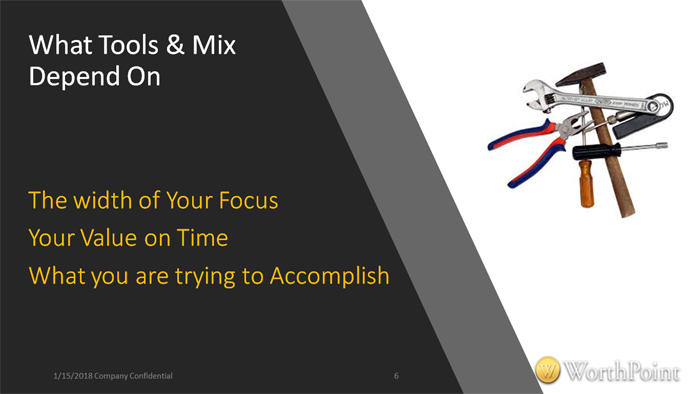
That gets into our next slide. We are the leading toolkit. We’ve got a huge amount of people using it. We have all kinds of neat things in regards to partners. I was just out with Steve Sipe at Global Authentications in California last week going through some autograph collections that I’m going to be writing up some stories about in three different autograph collections that I purchased over the last couple months, or had a chance to purchase, because one I turned down. A lot of the resources I found for all this was on WorthPoint, and I’m really not an autograph expert, by any stretch of the definition, but I do know that you need to do your homework.
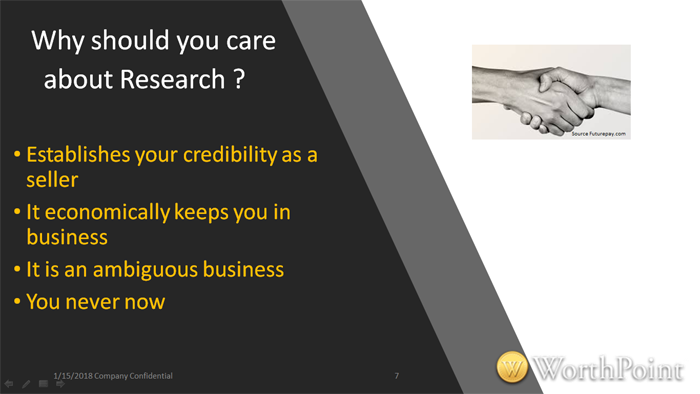
Our Marks Patterns & Symbols is a great place to look up marks. You can describe the mark and type it in and decide if you want pottery, metals, costume jewelry, and pick the vernacular of the area you want to look in. Just describe it, hit click, and we’ll bring you up all kinds of images, and it’s connected to our price database. If you find that mark you want, and you look it up, you can go right over to the Worthopedia and look at prices. It’s really pretty cool. We are the only person out there that do all this, and we are the only person to have close to a billion images on a website.

Some case studies of what we’ve help people do, or people have done on WorthPoint, or what they’re doing out in the marketplace, I think is really interesting. I laugh with this first one.
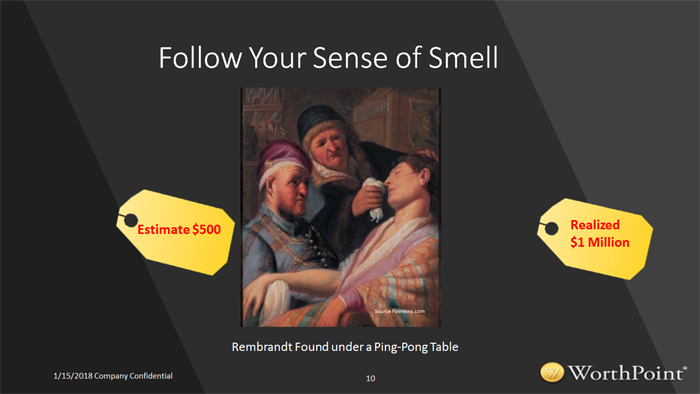
Some people like this painting, and some people don’t. It’s called A Sense of Smell. This was a Rembrandt that was recently found under a ping-pong table. I think it was in New Jersey, but I may have that wrong. The owner had died, and her sons had taken what they thought was the better stuff of the estate and packed it away and got to it a couple years later. The two brothers really didn’t like the painting, and they sent it out to an auction house that was hopefully knowledgeable about what they were selling. Even though it turned out they weren’t, and nobody liked it, including the auction house, they promoted the auction well.
Some people saw it online. The estimate from the auction house was $500, but the painting went for $1 million. At least it got good visibility, and people saw it, so knowledgeable people could bid on this. I say as a picker, the best stuff is still in people’s houses, and that’s where you want to get is into people’s houses to try to buy. Here’s a good case of a Rembrandt that was stored under a ping-pong table that was a known painting that had been missing for years from collectors trying to find it. They finally did. The auctioneer had to ask later about why it went for a million dollars, and somebody told him.
Toss it out on eBay and find out with an auction.
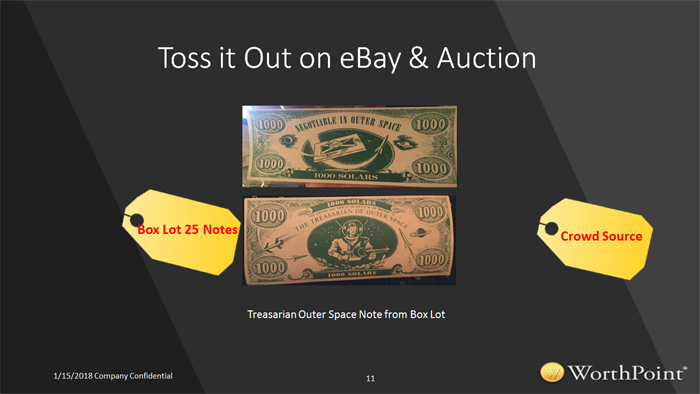
This is some paper money that I still haven’t gotten around, after a month, to listing that I found in a box. I still haven’t figured out how it got into the foyer of my house, but it was mailed to me 11 years ago in some stuff I had bought. For those of you that know me, I have a huge inventory. I’ve looked all over the web for this money. I’ve asked experts. I’ve asked Harry Rinker, and nobody knows what this play money is, but play money is quite collectible. In some cases, I believe, they even slab it now and grade it like real money. So there’s good money in play money.
These are notes that I found in this box that I must have dumped in the foyer when I was over at the warehouse and just brought one box back with me. It’s from the Treasarian of Outer Space. I’m guessing it went with a game set, but I’ve looked all over the internet, and I can’t find it. Experts don’t know it. I have no clue what to sell it for, and I’m probably just going to put it out in an eBay auction and start it at a low price, and see if the marketplace can tell me. I have 25 of them. They’re different values from different planets. I’m assuming they’re from the 1950’s. If anybody sees this when we publish this out on the web, please tell me. It’s something I have no clue how to price.
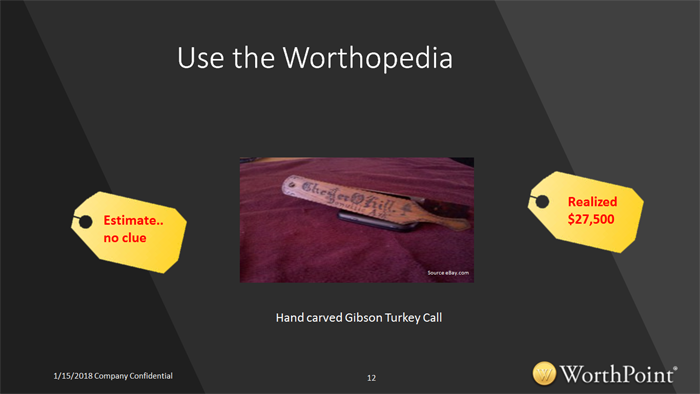
I did a combination of those two things with my turkey call. This is what I picked up on an estate call here in Atlanta with a fill my car deal. I paid the people $10,000 to take what I wanted out of the house and fill my car. This turkey call brought $27,000 on eBay. Now, I do have to say that I knew it was an expensive item when I went to list it. I did not know it when I bought it. I just liked the carving on it. This is not exactly the one I sold. Mine had different carving, but it was very similar, and it was signed, just like this one.
What was unique about these is only about a dozen of them are known. They’re carved by the person that patented the box call, which is a type of call that you hold in your hand and you rub the paddle on top back and forth over the box below it. It will squawk like a turkey. There’s about a dozen of these known. When I got it, I looked it up on WorthPoint and found it, because it’s called a Gibson Turkey Call, and Mr. Gibson signed it. That’s when I got an inkling. The last one that had sold was for $15,000. I started this in an $0.99 auction on eBay, and the last-minute sniper bid came in at $27,510, I believe that was the number.
So, I started an auction. I know that turkey hunters are very competitive. There’s some areas on eBay I think are better auctioning than others, that are more competitive, and people are sure to see things. While I don’t do many $0.99 auctions anymore, I generally start them at about 25% of what I think something may be worth, but I’m a huge fan of auctioning in areas that I think are well vetted and people look at a lot, and where auctions are going to be competitive. Turkey hunters are certainly competitive. That may be an understatement. That’s an example of combining the research with finding something only I could find on WorthPoint that the prior one had sold on eBay many years before, and it was scare, and then using auctioning to bring it up to the correct market value.
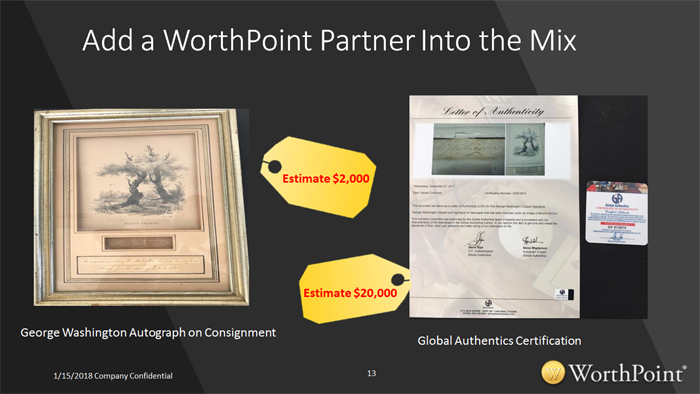
A WorthPoint partner, Steve Sipe (Global Authentics) I think is the most flexible in the autograph industry for how he does his pricing. As a WorthPoint member, you can send a picture to Steve of your autograph. I believe this is still free for WorthPoint members, but certainly it’s very inexpensive. I think it’s $10 if you’re not.
Steve will give you an opinion on whether you should follow up with sending it in, in regards to whether he thinks it has the potential of being real or not. It was funny. When I was out with Steve last week, some guy was sending in about his hundredth image of an autograph. The poor guy, I don’t know where he’s shopping or buying them, but they’re not right. Steve is very good about getting back to people. His pricing is very real. I have about 100 items up now on eBay that he’s done for me. I tend to send things in groups where I can get a discount even further.

I would highly recommend you guys, for an autograph, check Steve out. (Global Authentics) It adds to the credibility of what you have for sale, and you can take it from $2,000, I think it’s George Washington, to $20,000, I know it’s George Washington. You can sell with much more credibility, and you don’t have to worry about what you’re saying or about things coming back. Again, it goes to what I’m saying. Get rid of the nebulousness of your listings. Do I know versus I think, and you’ll be surprised how much better you do.
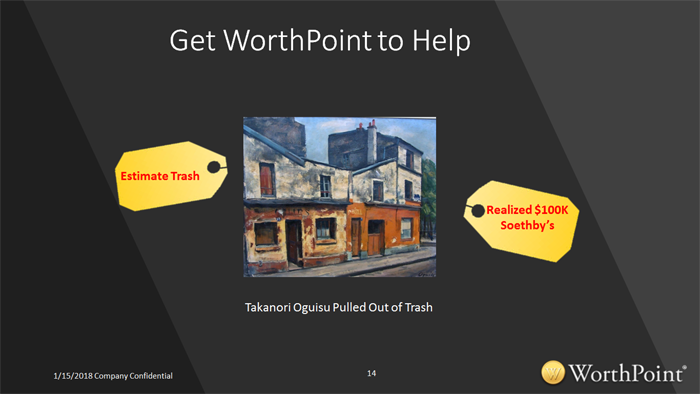
WorthPoint is going to probably reinitialize a group of experts in the company whose services we recommend you use for estimates or for appraising. We’re not going to do an ask a Worthologist like we used to, but have a related service with experts that we think are good to go to. Here’s an example where we fielded the question with knowledge of people that we had on staff when I was on news at NBC in Denver talking about what people could find and be worth money.
A lady emailed me about a TakanoriOguisu. She didn’t know who this painting was by. She had pulled it out of the trash in Boulder, and there’s a video on WorthPoint about this. She got this out of the trash several years before we were on television. She was using this painting in her closet to prop up school papers for her daughter, and she had nearly thrown this painting out several times, because she hated the colors. Thank God she didn’t.
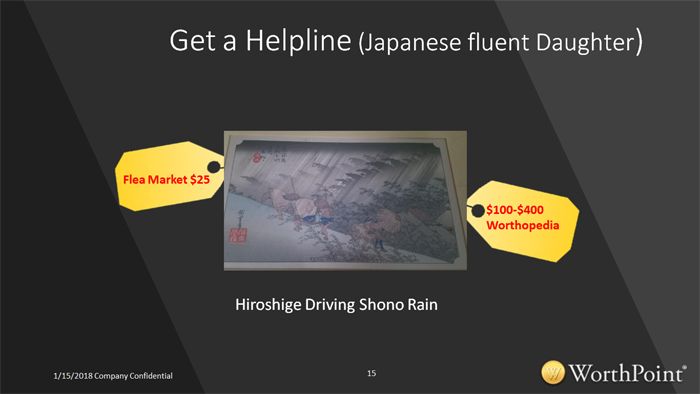
She sent me a photo, which I shared with one of the people on staff here, and he recognized it right away as a TakanoriOguisu impressionist painting, with a stretcher in the back of the canvas. I tell people on paintings the back is usually more important than the front. Looking at the stretcher and the canvas, we believed it was real, and Soethby’s authenticated it. She sold it at Soethby’s for $100,000. Just from something she had pulled out of the trash. So, the stuff is out there. People are finding more of it every day, and that’s one of the things, that and learning make our industry so exciting. WorthPoint has a lot of resources it can throw at things.
This is an example of the help line that I used with my daughter, in regards to the Hiroshige print. I think it’s a second period, but I haven’t bothered to do further research yet. I wouldn’t know a Hiroshige print from a Burger King print. My daughter helped me at least decipher it right away. She knew the print anyway. I bought it for $25, and even if it’s a second-generation print, it’s $100-$400, I guess. Again, it’s a good example of being able to use the help line, as I said. In this case, I’m giving her the print to hang in her room, so the value doesn’t really ultimately matter, but she enjoys it, and I know I got a good deal. It’s a win-win for everybody.

One of the things that I love to do when I get down to research, and for those of you that know or don’t know, I’m about to launch a new website called History In Photos, which I’ve been talking about for a little while, where we sell very high end prints of old black and white glass negatives. I’ve been collecting these for about 15 years. This is one I actually purchased on eBay that I liked because it pertained to the Civil War.
The seller had no clue about where this photo was taken. One of the neat things you can do with items is blow them up and do your research better. That’s what I did with this photo, because it had so much clarity. Then we’ll go and restore it anyway and take all the white dots that you may see on the picture on the right out and make it much sharper.
By zooming in on the high resolution of this photo, which glass slides usually are, I was able to get the name off the side of the warehouse that’s behind the statue and do a Google search on that business.
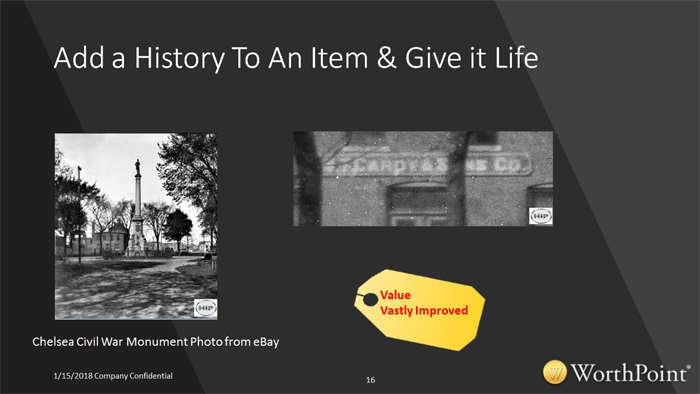
I found that business back in Chelsea, Massachusetts in the late 1800’s. All of a sudden, I can put some provenance on this image and know where it’s from and what it was about. That makes it much more interesting to people. Again, this is a Civil War monument. We’ll probably sell about 100 images of it and then retire it. Chelsea, Massachusetts. There’s my little moniker now on the bottom of the screen, HIP, History In Photos.
By doing a lot of research, and this really didn’t take me that long, I can increase the value of what I’m selling, which I think is just so critical. When I started in this business, I didn’t believe it. I thought it was all about the economic strict value of something. After so many years in the business, I learned the story and the provenance of the item is just as important as anything when you go to sell it.
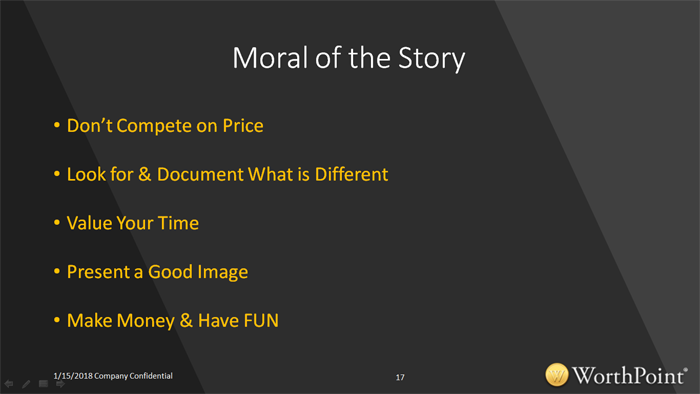
So, the moral of my story is, and some stalker of my webstore from New England told me they’ve noticed I don’t compete on price. I don’t. If I’m in a hurry to move something, I’m more motivated on price. If I need some money to pay my mortgage that week, I’m more motivated about price. Don’t set you up your store to compete on price. It’s a losing proposition. It devalues you completely.
The second moral, when I’m shopping, I look for what I think is different. What is different about this item I’m going to sell? Why is it different? Why should I be proud to have it my store as something different? Document why it’s different. It’s very critical. People like to buy things that are unique. I get so many compliments about stocking my store, and I have about 7,000 items in my store that are for sale, which is the tip of my iceberg. God knows, I probably don’t need to buy any more for my lifetime, and I could keep stocking new items.
Also, value your time. Your time is money. You are important. You’re important as a seller. If you don’t value your time, nobody is going to value your time. I like that noise on my phone. I just got money in eBay. Value your time. Think about how you do everything efficiently. Shipping is even set up efficiently for me. I have an inventory of boxes and packing material from our good friends at Bubblefast, so I can pack things very quickly.
Present a good image in your store. People laugh, because in my store, if you look at my photos, my thumb is my trademark in my photos. I should register it as a registered mark of Will, but I do take a lot of photos. I take them with an SLR camera, and if my thumb is over something in one photo, it’s not in another. You get really good images in my store. I get complimented on that.
The thing I can’t stress enough. There are obnoxious buyers out there, but keep in mind they’re a passionate group, and generally they want to follow their passion and buy something. I don’t let them drive my schedule. I have to go home and check an item tonight. I just got home from a week of travel, and I have a buyer that really wants to buy something, and she had sent me about 20 emails in a span of three days. I had to tell her to relax.
I’ll check on it for here when I get home. It’s not going to go anywhere. Don’t let her drive you to insanity. In this case, manage her and make sure you have fun, and make sure she has fun and ultimately gets what she wants, and everybody has fun. We’re in a lifestyle business. Still, like me, I need to make money, but I’m going to make sure it doesn’t stop me from having fun and change it so I hate what I’m doing. I used to do that from 9-5, and I quit.
That’s all the presentation I have. If you want to follow up with any questions, that would be great. I can’t stress enough, this should be fun, and it’s very manageable. I’ve sent five kids through college on money I’ve made off of eBay, besides paying my bills.
Danna: Thank you Will for sharing this great information with us. You can visit Will’s eBay store at: Wills1N4
FYI: Below is the video replay from the webinar presentation.
NOTE: if you would like to do a webinar with me and share your knowledge about selling on eBay: CONTACT ME with your information.
Further reading:
https://powersellingmom.com/ebay-research/worthpoint-ebay-sellers-resource-collectibles-antiques-art-identification/
